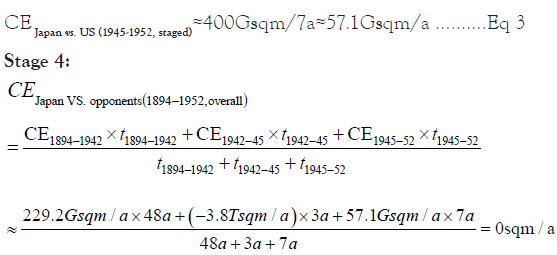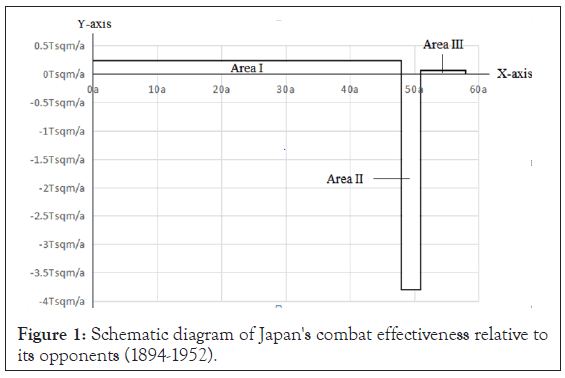Journal of Defense Management
Open Access
ISSN: 2167-0374
ISSN: 2167-0374
Research Article - (2022)Volume 12, Issue 6
Combat effectiveness is the core of all military monographs, and its measurement is also the basis of many war studies. We propose a new research pathway and describe an appropriate mathematical method to reach universally applicable results. Our method requires only simple spatial and temporal data to calculate combat effectiveness without relying on subjective assumptions that involve other parameters. A reader asked us a question in his letter: why did he use the measurement formula given by us to measure the combat effectiveness of the Japanese army in the first half of the 20th century as 0? We explained this: What he measured was the overall combat effectiveness of the Japanese army relative to its opponents. Before the United States entered the war in 1942, the combat effectiveness of the Japanese army was stronger than that of its opponent. After the United States entered the war in 1942, the combat effectiveness of the Japanese army was weaker than that of its opponent. The two cancel each other, so the overall combat effectiveness was equal to zero.
Combat effectiveness; Measurement methods; Overall combat effectiveness; Japanese army; The Pacific War
If you want to overcome your enemy you must match your effort against his power of resistance, which can be expressed as the product of two inseparable factors, viz. the total means at his disposal and the strength of his will [1].
Which of the two sovereigns is imbued with the Moral law? Which of the two generals has most ability? With whom lie the advantages derived from Heaven and Earth? On which side is discipline most rigorously enforced? Which army is stronger? On which side are officers and men more highly trained? In which army is there the greater constancy both in reward and punishment? By means of these seven considerations I can forecast victory or defeat [2].
Combat effectiveness is the core of all military monographs, and its measurement is also the basis of many war studies. Hayward [3] was the first scholar to explicitly put forward combat effectiveness measurement. After the 1990s, scholars reopened research into the relationship between specific contributing factors and combat effectiveness. Helmbold [4], for example, further extended the Lanchester equation and put forward the concept of advantage parameter. Kier [5], Annas [6], Cigrang [7] and Daffey-Moore [8] realized that the main weakness of the Lanchester equation was that it ignored how individual differences (including mental and physical) between soldiers could greatly affect combat effectiveness; accordingly, they proposed to carry out a detailed study of this problem. Meanwhile, Zanella [9], Kantliev [10] and King [11] sought to explore the different roles of different army sizes in modern war. In addressing the relationship between weapons and combat effectiveness, and focusing in particular on lethality and destructive power, Raymond [12], Gordon [13] and Carrier [14] discussed the role of actual combat training in weapon performance and focused in particular on its impact on combat effectiveness (from a social perspective). Rotte and Sloan [15,16] expand beyond the focus on soldiers and weapons to consider how the general's tactical ability impacts combat effectiveness. Nielsen [17] focuses on the impact of civil military relations on combat effectiveness, while Reiter [18] and Heinecken [19] adopt a macroscopic perspective to assess the impact of the social system on morale and logistics, and also consider the resulting impact on combat effectiveness.
In April 2021, Research Square (a preprint platform) carried an article by ours. In this paper, we use Galilean idealization and domain theory to suggest solutions and propose an appropriate mathematical method to reach universally applicable results. Specifically, our measurement method is:
The theory of territorial behavior argues that the essence of territory is the physical space that ought to be defended and it asserts that armed conflict will occur if unauthorized external forces cross the boundary [20]. Combat is, in other words, an invasion of territory by armed forces of another state or political entity, or a counterattack to ward off such an invasion; by implication, combat effectiveness is the measure of the ability to invade and counterattack, or to alter and maintain territorial boundaries, and a measure of the overall success of the operation. Changes in territorial boundaries are the very outcome of an armed conflict and can be used to measure combat effectiveness [12].
Despite the inherent difficulties in measuring territorial change with great accuracy, we begin with the following formula or measurement of combat effectiveness:

Where CE is the combat effectiveness relative to the enemy; ΔS represents changes in territorial control; and t expresses the time required to alter boundaries and complete occupation. The formula can measure average combat effectiveness within a certain period. Spatial changes are measured in square meters and time in years, expressed as sqm and a respectively. Thus, the basic unit of measuring combat effectiveness is square meters/year, expressed as sqm/a.
For more than a year, there has been a lot of attention and discussion about this approach. We have received a lot of letters in this regard. Thanks to the Editor-in-Chief of the Journal of Defense Management who has been kind enough to give us an opportunity to respond.
One of the letters from an anonymous person said
Recent combats often resulted in no such changes (the change of control over areas) at all. If you take Japan as an example between 1900 and 1945, you will see that-in your words-the results of holistic measurement are: 0 sqm/a, but Hiroshima and Nagasaki totally destroyed, the Tenno's role marginalised, thousands of so-called "comfort women" raped.
We explained this
An important misconception may arise from confusing overall combat effectiveness and stage combat effectiveness like this letter, and thus failing to understand that “a value of zero for overall combat effectiveness does not indicate a bloodless war without any severe damage to property; It only shows that the combat effectiveness of the adversaries can completely offset each other”.
The territory of Japan in 1894 and 1952 ("1900-1945" as stated by the letter is inaccurate) was roughly the same, so according to formula, Japan's combat effectiveness throughout this entire period was zero. This may seem incomprehensible to some readers, because it is well known that most of this period coincides with the period of Japanese militarism. To understand this issue, we first divide this period into the following three stages:
Stage 1: It took Japan 48 years (1894 to 1942) to expand its power- space by 11 million square kilometers (11 Msqkm=11 Tsqm) [21]. By substituting the data into the formula, we get

Stage 2: It took the United States three years (from 1942 to 1945) to defeat and occupy Japan (area: about 400,000 square kilometers, 400 ksqkm=400 Gsqm=0.4T sqm), and relieve the peoples of Asia from Japanese occupation (11Tsqm). By substituting the data into the formula, we get:

Stage 3: From 1945 to 1952, the United States withdrew its troops and its combat effectiveness gradually decreased to zero. After seven years of democratic reforms, Japan gained the trust of the United States and attained the same power-space it controlled before 1894. By substituting the data into the formula, we get

The above calculation shows that a value of zero for Japan's overall combat effectiveness during the period 1894-1952 does not suggest there was no war or severe casualties and destruction during this period, but rather that Japan’s combat effectiveness deployed to invade Asian countries was completely offset by US combat effectiveness deployed against Japan. We can use the coordinate diagram to intuitively display this cancellation effect, as shown in Figure 1.

Figure 1: Schematic diagram of Japan's combat effectiveness relative to its opponents (1894-1952).
In Figure 1, this cancellation effect is shown as the area of the upper half of the Y-axis (Area I+Area III) is equals to the area of the lower half (Area II). In the real world, this offset is reflected in the death toll and the depletion of military resources on both sides. Moreover, careful readers should notice that the combat effectiveness the United States deployed in World War II exceeded that of Japan (Area II>Area I), and the excessive combat effectiveness(Area II-Area I=-Area III) was translated in the occupation of Japan and the imposition of democratic reforms after 1945. Due to the modern concepts of justice for the preservation of national sovereignty and territorial integrity, the United States chose to withdraw from Japan (please note that the American troops stationed in Japan after 1952 were no longer an occupying force), that is, to withdraw its excessive combat effectiveness. After the withdrawal, the combat effectiveness of the US and Japan canceled each other out. The combat effectiveness is only satisfied with offsetting the combat effectiveness of the opposing power (as Japan aimed at invasion whereas the US aimed at counter-invasion), which is the mathematical embodiment of the principle of territorial justice and the rule of international law in the modern world. We would like to propose that metaphors applied in other fields could help readers better understand this offsetting phenomenon:
• The process is similar to pouring acid into a glass of water first, and then adding just the right amount of base to fuel a complete reaction, after which one still gets water (The pH value did not change before and after the reaction, but it can't be said that there was no reaction).
• If the total amount of food produced in a certain area in a given year happens to be equal to the consumption of food in the same area, then the overall growth rate of food in that area and year is zero; but this does not negate the existence of economic activity.
• The number of wives of a man who has been divorced is 0, the same as he was before marriage. This is just because marriage (number of wives: +1) and divorce (number of wives:-1) cancel each other out, and it cannot be concluded that he never had a married life.
• Cold and warm air consumes each other on the front to form rainfall. The front in meteorology can be compared to the front in a war, while the rainfall is equivalent to casualties and material damage. A war with an overall combat effectiveness of about zero is equivalent to rainfall under a quasi-stationary front.
We present a quantitative method of history based on the idealized paradigm and explain how this method can be applied to combat effectiveness measurement and mathematical modeling. Future research should apply the method proposed in this paper to measure the combat effectiveness of armies across human history and perhaps build a database that can serve as a pool of resources for military mathematical models and military simulation software. In addition, we also look forward to more academic letters about our articles.
Citation: Wang J, Sun W (2022) Misconception and Clarification: A Brief Discussion about the Article "Value and Methods of Measuring Combat Effectiveness: A New Approach". J Defense Manag. 12:253
Received: 17-Jun-2022, Manuscript No. JDFM-22-18838; Editor assigned: 24-Jun-2022, Pre QC No. JDFM-22-18838 (PQ); Reviewed: 13-Jul-2022, QC No. JDFM-22-18838; Revised: 21-Jul-2022, Manuscript No. JDFM-22-18838 (R); Published: 29-Jul-2022 , DOI: 10.35248/2167-0374.22.12.253
Copyright: © 2022 Wang J, et al. This is an open-access article distributed under the terms of the Creative Commons Attribution License, which permits unrestricted use, distribution, and reproduction in any medium, provided the original author and source are credited.